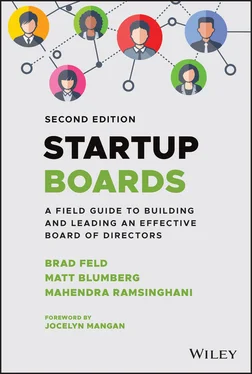Brad Feld - Startup Boards
Здесь есть возможность читать онлайн «Brad Feld - Startup Boards» — ознакомительный отрывок электронной книги совершенно бесплатно, а после прочтения отрывка купить полную версию. В некоторых случаях можно слушать аудио, скачать через торрент в формате fb2 и присутствует краткое содержание. Жанр: unrecognised, на английском языке. Описание произведения, (предисловие) а так же отзывы посетителей доступны на портале библиотеки ЛибКат.
- Название:Startup Boards
- Автор:
- Жанр:
- Год:неизвестен
- ISBN:нет данных
- Рейтинг книги:3 / 5. Голосов: 1
-
Избранное:Добавить в избранное
- Отзывы:
-
Ваша оценка:
- 60
- 1
- 2
- 3
- 4
- 5
Startup Boards: краткое содержание, описание и аннотация
Предлагаем к чтению аннотацию, описание, краткое содержание или предисловие (зависит от того, что написал сам автор книги «Startup Boards»). Если вы не нашли необходимую информацию о книге — напишите в комментариях, мы постараемся отыскать её.
Startup Boards: A Field Guide to Building and Leading an Effective Board of Directors
Startup Boards
Startup Boards — читать онлайн ознакомительный отрывок
Ниже представлен текст книги, разбитый по страницам. Система сохранения места последней прочитанной страницы, позволяет с удобством читать онлайн бесплатно книгу «Startup Boards», без необходимости каждый раз заново искать на чём Вы остановились. Поставьте закладку, и сможете в любой момент перейти на страницу, на которой закончили чтение.
Интервал:
Закладка:
Is a Proactive Communicator: A good chair manages all one-on-one communications proactively with the CEO. While any board member can choose to mentor and guide the CEO, the chair has special responsibility for synthesizing all of the feedback and delivering it to the CEO consistently.
Helps the CEO Set the Board Agenda: While the CEO will set the agenda for each board meeting, the chair helps by collecting feedback from other directors about what they want to cover. The chair then helps the CEO create an agenda that will effectively engage board members in a vibrant discussion.
Manages the Clock: Board members are busy people with significant and conflicting demands on their time. It's essential to begin and end the meeting on time, conforming to a predefined agenda and moving the conversation along when it stalls.
Maintains Culture and Hygiene: As an advocate for the company, the chair creates and maintains a positive and constructive culture, especially in times of challenge and stress. Wasting time, allowing a hostile dynamic between board members to become the norm, alienating individual board members, or overemphasizing individual flaws are not helpful.
Helps the CEO Process Board Feedback: The chair is responsible for gathering feedback from other directors by taking notes in Executive and Closed Sessions and spending time with the CEO after the meeting to debrief that feedback.
Following are some thoughts from Karen DeGolia (Vontier, Board Chair), who has been a chair or lead director multiple times.
The role of a lead director is to make sure that the board is completing its work of governance, making sure the agenda properly reflects what the company needs to communicate or get approval for, as well as what the directors want to know. It also involves working with the CEO to make sure that the interaction between the CEO and the company is effective, helpful, and productive for all parties.
The lead director often becomes a very trusted confidant for the CEO, which is somewhat of a lonely job. As CEO you can't really confide in most of your direct reports on every topic and the chair or lead director is the person that you can confide in. It's really important for the CEO and lead director to have a great interpersonal relationship that allows that CEO to actually be vulnerable and share what they think is working well or isn't. The lead director can collaborate to find good solutions to assist the CEO in their work.
An effective lead director needs to have excellent EQ (emotional quotient) because you need to be able to understand where the different parties (directors or management) are coming from and help work through discussions to resolve issues in a way that makes everyone feel that they've been heard and that all elements were considered. It's important to understand where people are coming from and make them feel that the time that they commit to is productive and valued. That takes a fair amount of listening and humility.
Finally, a good lead director realizes that it's not about them. In order to be successful, the lead director should walk into a room with a team, rather than a power, mindset.
Karen DeGolia, Vontier, Board Chair
Executive Chair
The executive chair is a chair who is an active member of the management team rather than an outside director. Often the executive chair is a founder of the company and can often be the largest non-investor shareholder in the business. It can also be a founder who was previously the CEO but has handed that role to another founder or hired someone to be the CEO. An executive chair can be a full-time or part-time employee of the company, but in either case, has a significant role in some aspect of the company.
Few people have been as successful as Reid Hoffman as executive chair. Reid co-founded LinkedIn and is also a partner at the VC firm Greylock, a significant investor in LinkedIn before Microsoft acquired it. Here, Reid explains how he approaches the role of executive chair (which officially was “Executive Chairman” while he was at LinkedIn).
A few years after I co-founded LinkedIn in 2003, I decided to shift my role from CEO to executive chairman. While there are a relatively clear-cut set of roles and responsibilities attached to the CEO's job, an executive chairman at company X may play a much different role than the executive chair at company Y. It's a nebulous job title and depends on the company in question and the person filling the role.
I made the shift because LinkedIn was in a state of transition, shifting from a startup to a growth-stage company. I love articulating a product vision and other facets of early-stage entrepreneurship, but I'm less interested in organization building, international expansion, and developing scalable business processes. Becoming executive chairman allowed me to continue playing a highly active role at LinkedIn regarding strategy and several key projects while handing off the operations to the CEO.
Jeff Weiner became CEO in 2009, and, while I remained extremely involved at LinkedIn, the division of responsibilities between us was extremely clear. The buck stopped with Jeff. If Jeff made a decision, that decision was made. Period. While I tried to offer Jeff honest and candid advice and even challenged him, he had operational control over the company. Jeff worked for the company, not for the executive chairman or the board, although the board could choose to replace him.
Trust is the critical factor in an executive chairman and CEO relationship. Neither works explicitly for the other, and no one reported to me. I was careful never to override the organizational chain of command.
My most important job as executive chairman was helping Jeff do the best job possible. Sometimes this meant helping recruit and retain great people. Sometimes this meant helping launch an international expansion or a new product. It always meant being a great partner to Jeff and the entire executive team so that we could advance our vision of bringing economic opportunity to every professional in the global workforce with our thousands of LinkedIn colleagues around the world.
Reid Hoffman, Greylock Partner, LinkedIn Founder, and Executive Chairman until the sale to Microsoft
Should You Be Chair of Your Board?
Until the Enron scandal and the ensuing Sarbanes-Oxley legislation in the early 2000s, almost all US-based CEOs were board chairs of their company. Today, 75% of public companies in the United States are still set up that way, although there is a growing movement to separate CEO and chair roles. There are good reasons for that, with larger, public companies and private companies with long and checkered pasts rife with governance issues. It's also common for nonprofits and associations with different stakeholder structures to separate the CEO and board chair roles. However, in closely held private companies, it probably doesn't matter much.
If your board or a major investor insists on someone else being chair, you can always push back and suggest appointing a “lead independent director” instead. If you are a CEO at this type of company, having a lead director or not being the board's chair primarily means two things:
1 You still run the meetings and write all the materials since you run the business.
2 You have one person to consult with on the meeting agenda and the materials ahead of time.
Matt (the founder/entrepreneur) prefers combining the CEO and chair role as the overall leader of the company for a private company, but he can see both arguments. In contrast, while Brad (the VC) is fine with the combined CEO/chair role, he prefers a CEO + lead director role in private companies, especially at later stages.
Independent Board Members
Интервал:
Закладка:
Похожие книги на «Startup Boards»
Представляем Вашему вниманию похожие книги на «Startup Boards» списком для выбора. Мы отобрали схожую по названию и смыслу литературу в надежде предоставить читателям больше вариантов отыскать новые, интересные, ещё непрочитанные произведения.
Обсуждение, отзывы о книге «Startup Boards» и просто собственные мнения читателей. Оставьте ваши комментарии, напишите, что Вы думаете о произведении, его смысле или главных героях. Укажите что конкретно понравилось, а что нет, и почему Вы так считаете.












